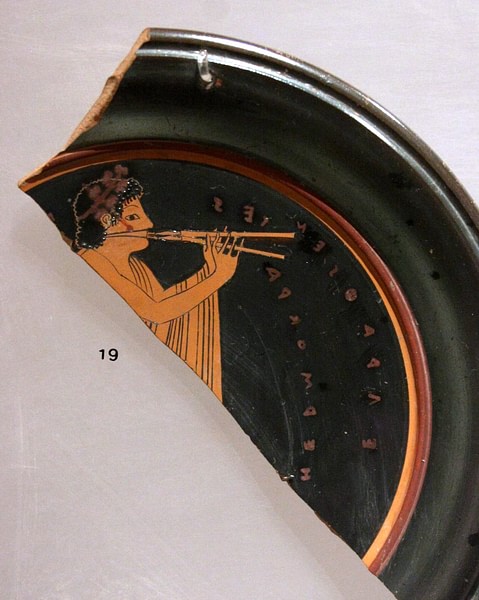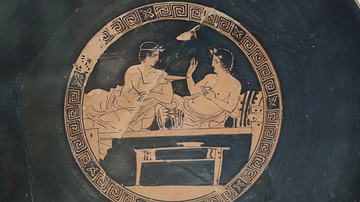
The Aulos was a musical wind instrument played by the ancient Greeks. It was also known as the kalamos or libykos lotos, which referred to the material from which part of the instrument was made: respectively, the reed and the Libyan lotus plant. Perhaps the most commonly played instrument in Greek music, the aulos was played in festivals, processions of births and deaths, athletic games - for the athletes to keep their exercises in rhythm, social occasions, and performances of tragedy in the Greek theatre. It was associated with the god Dionysos and often played at private drinking parties.
Features
Made from cane, boxwood, bone, ivory, or occasionally metals such as bronze and copper, the circular pipe (bombyke) was fitted with one, two or three bulbous mouthpieces which gave the instrument a different pitch. The pipe itself could be composed of up to five closely interlocking sections. Sound was produced by blowing and vibrating the single or double reed (glottides) within the mouthpiece. Seven holes (tremata) were cut down the length of the pipe with sometimes an additional hole to produce another octave of notes. Tonality could be adjusted through the turning of bronze rings between the mouthpiece and the pipe. Frequently, two auloi were fitted together (diaulos) at the mouthpiece to produce a richer sound or double melody. The sound produced by an aulete (player) was rhythmical and penetrating, and he often accompanied a male chorus.
Aulos players from Thebes (c. 400 BCE) are credited with inventing rings and keys (pronomos) made from silver and bronze which could open or close various holes on the instrument, functioning much like keys on modern wind instruments such as the clarinet.

Surviving Examples
The earliest surviving examples of auloi have been found at Koilada, Thessaly and date from the Neolithic period (c. 5000 BCE). These instruments are carved from bone and have five holes, irregularly placed down their length. A complete double aulos in bone with tonal bronze rings survives from 4th century BCE Thessaloniki and many fragmentary pieces have been excavated on Delos where there is also evidence of a workshop. The earliest representations in art come from small marble statues from Keros in the Cycladic islands (2700-2300 BCE). Aulos players, both male and female, are commonly depicted on Attic red- and black-figure vases from the 7th century BCE and include depictions of Hercules and Satyrs playing the instrument. Decorated pottery also, on occasion, depicts the leather strap (phorbeia) which held the instrument in position over the mouth and even the instrument case (sybene) over the shoulder of the player.





